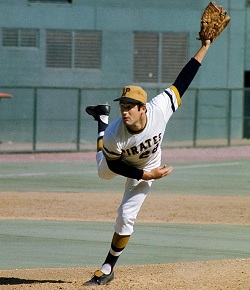 ERIC: From 1968-1972, Steve Blass of the Pittsburgh Pirates was on the very best pitchers of all of baseball. In 1968, he went 18-6, with a sparkling 2.12 ERA. The following season, he went 16-10, and in 1970, he had a bad season, going 10-12, but with a solid ERA of 3.52. In 1971, his Pirates won the World Series, and Blass went 15-8, with a fine 2.85 ERA. He led the National League in shutouts that year, with 5. He also won two games in the World Series. In 1972, Blass had his best season yet, posting a fine 19-8 record, with an excellent ERA of 2.49. He finished second in the Cy Young Award voting that year, and pitched in the All Star game, and then won his only start against the Cincinnati Reds during the National League Championship Series. At the end of the 1972 season, Blass had a career record of 100-67, and was only 30 years old. He should have had many more years of success as a Major League pitcher.
ERIC: From 1968-1972, Steve Blass of the Pittsburgh Pirates was on the very best pitchers of all of baseball. In 1968, he went 18-6, with a sparkling 2.12 ERA. The following season, he went 16-10, and in 1970, he had a bad season, going 10-12, but with a solid ERA of 3.52. In 1971, his Pirates won the World Series, and Blass went 15-8, with a fine 2.85 ERA. He led the National League in shutouts that year, with 5. He also won two games in the World Series. In 1972, Blass had his best season yet, posting a fine 19-8 record, with an excellent ERA of 2.49. He finished second in the Cy Young Award voting that year, and pitched in the All Star game, and then won his only start against the Cincinnati Reds during the National League Championship Series. At the end of the 1972 season, Blass had a career record of 100-67, and was only 30 years old. He should have had many more years of success as a Major League pitcher.
Instead, the wheels inexplicably came off.
He developed what’s now commonly called “Steve Blass Disease.” Blass suddenly found himself unable to find the strike zone with any consistency. His ERA climbed to an astronomical 9.81 in the 1973 season. He walked 84 batters in 88 2⁄3 innings, and struck out only 27, posting a 3-9 record along the way. He was sent to the minor leagues in 1974 where he walked nearly 100 batters in only 64 innings, and retired in 1975 because he could no longer throw strikes. It was all a mystery: there was nothing physically wrong with Blass that any doctor could identify. His fastball still had good velocity. He suddenly found himself unable to hit the broad side of a barn with that good fastball.
Nothing that Blass, the Pirates, or the medical staff did could identify the problem, or find any success in treating it. Blass tried everything from psychotherapy to transcendental meditation to cure himself of the “disease” that had been named for him. “The bottom of the pit, the abyss as I call it in the book was just devastating because I didn’t know why this was happening,” said Blass. “I won 19 games, finished second in the Cy Young, and then I can’t find home plate. It was humiliating; it was embarrassing. There’s nothing worse for a professional major league athlete then being in the arena, and knowing you shouldn’t be there.”
Consequently, “Steve Blass Disease” has entered the baseball lexicon. The “diagnosis” is applied to talented players who inexplicably and permanently seem to lose their ability to accurately throw a baseball. Notable victims of “Steve Blass Disease”include Bruce Ruffin, Rick Ankiel (who resurrected his career as an outfielder), Mark Wohlers, and Dontrelle Willis, who retired earlier this season.
The fielder’s variant of “Steve Blass Disease” is sometimes referred to in baseball terminology as “Steve Sax Syndrome,” for former Dodgers all star second baseman Steve Sax, who found it impossible to make accurate throws to first base. Other victims of “Steve Sax Syndrome” include another former all star second baseman Chuck Knoblauch and former catcher Mackey Sasser.
Blass ended his career with a career record of 103-76 and a very solid 3.63 ERA. He should have won many more games, but for the onset of the disease that befell him. Sadly, “Steve Blass Disease” is fatal to pitching careers.
In spite of it all, Blass has kept his humor and has enjoyed life. In 2009, he sent a record of a completely different variety that demonstrated his ability to still be accurate at something: he posted two holes-in-one in a single round of golf. Only ten holes separated his two aces. After starting his round on the 10th hole, Blass aced the 15th hole, dropping an 8-iron in the cup from 164. He then aced the 7th hole with a 7-iron from 175 yards.
Blass, who has been a broadcaster for his beloved Pirates for many years, maintains a great attitude about it all, even in spite of inspiring the disease he’s most famous for. “Played in an All-Star Game, a World Series, played with three hall of famers – Maz, Clemente and Stargell. I mean this is fair tale stuff,” said Blass. “The Pirates, when I was 18, gave me a chance to live that dream and I’m still living it, so they have my loyalty forever.” He still wears his 1971 World Series ring to remind him of what a charmed life he led before it all went south. “Out of a fairy tale life, I had two very difficult years, but on each side of that it’s been absolutely terrific,” he says.
This spring, the 70-year-old Blass published his memoirs, titled A Pirate for Life.
Here’s to Steve Blass for his unwanted contribution to the baseball lexicon, for which we induct him into the You Stink! Hall of Shame.



Discussion
No comments yet.